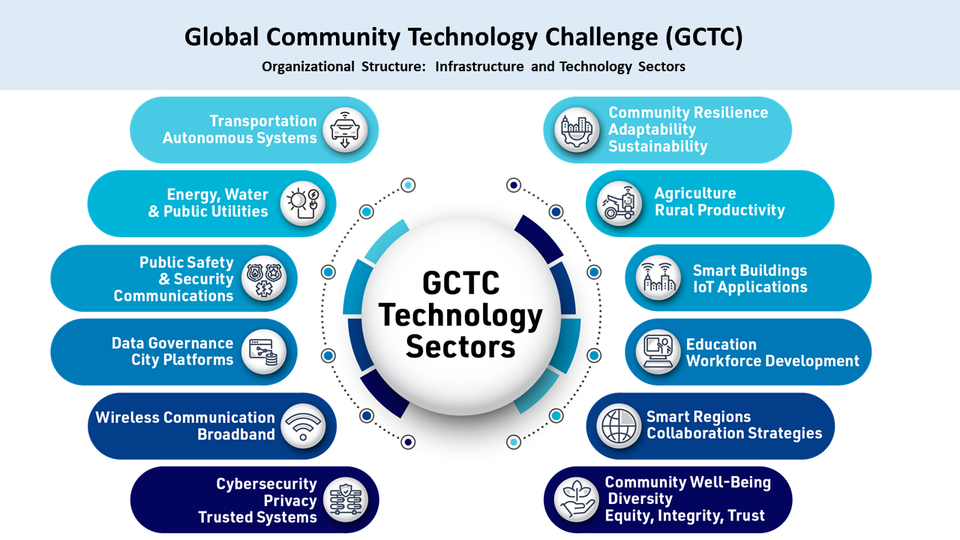Global Community Technology Challenge

Background and Purpose: In 2014, NIST launched the Global City Teams Challenge (GCTC), now renamed the Global Community Technology Challenge (GCTC), to encourage smart city and Internet of Things (IoT) stakeholders to develop and deploy standard-based solutions that are replicable, scalable, interoperable, and that provide measurable benefits for cities and communities. GCTC seeks to help cities and communities learn from others, improve on successes and build consensus for standards.
The GCTC program has evolved to become a collaborative platform for cities, communities, industry, academic, and government stakeholders to jointly develop and deploy emerging technologies for smart cities and communities. The program strives to create an environment in which communities can benefit from working with others to improve efficiency and lower costs.
In the 2018-2019 round, the U.S. Department of Homeland Security Science and Technology Directorate (DHS S&T) joined the program as a co-host, and the subtitle of “Smart and Secure Cities and Communities Challenge (SC3)” was added to the program. The goal of the SC3 was to encourage smart city stakeholders to consider cybersecurity and privacy as a primary concern early in the process when developing and deploying solutions.
In 2019, the National Telecommunications and Information Administration (NTIA) joined the program as a co-host of the 2019 GCTC/SC3 Expo. Other federal agencies have also participated in the 2019 Expo as partners, including the U.S. Department of State, the International Trade Administration, the National Aeronautics and Space Administration, the Health Resources and Services Administration, and the United States Postal Service.
Fostering Innovation – ActionClusters and SuperClusters: The GCTC acts as a matchmaker and incubator, helping form public-private partnerships, dubbed Action Clusters and SuperClusters. NIST and its partners advise and nurture these Clusters in their development of groundbreaking, Internet of Things (IoT) applications for smart cities and communities. Since its inception, the GCTC has recruited over 200 Action Clusters, involving over 200 cities, and 500 companies, universities, and non-profits. Forty percent of these Clusters are outside the U.S. These Action Clusters are enabling innovation across the United States, Africa, Asia and Europe, as exemplified by the following projects:
- Cumberland, Maryland: Demonstrating a windshield-mounted smart phone, called "Roadbotics," allowing inspectors to drive and collect data on road conditions, which artificial intelligence analyzes for needed repairs.
- Calabar, Nigeria: Developing a system that converts waste into biofuels, industrial raw materials and organic fertilizers, while reducing CO2 and CH4 gases released into the atmosphere.
- Galway, Ireland: Pursuing projects that minimize light pollution and regulate atmospheric emissions, in keeping with European Union directives on air quality.
- Hamilton County, Ohio: Developing a text messaging platform, which uses artificial intelligence to help those struggling with opioid addiction connect with medical centers.
- Italy –Genoa, Milan, Turin: These cities are replicating a multi domain, Internet of Things for preventing environmental disasters in Genoa; aiding parking in Milan; managing waste in Turin.
North-central Indiana: A ten-county consortium, partnered with industry, is acquiring IoT-based, testbeds to educate workers and make the region's farming and manufacturing globally competitive. - Suwon City, Korea: Deployed an IoT and artificial intelligence-based platform for optimally managing public buildings' energy use and environment.
- Syracuse, New York: Creating guidelines for secure cloud services, enabling smart streetlight networks, catch basin monitoring, water metering, and other smart city applications.
Providing Opportunities to Meet and Collaborate: The GCTC sponsors events, which bring together local governments, nonprofit organizations, academic institutions, technologists, and corporations from around the world, seeking to develop smart cities and communities. These events include:
- Global City Teams Challenge Expo: The Expo has become the largest U.S. Government-hosted Smart City and IoT events. The Expo offers the opportunity to learn about smart city and smart community success stories, and meet leaders in industry, academia, and local, regional, and state government eager to collaborate and innovate. The Expo is usually co-hosted by multiple U.S. federal agencies including NIST.
- Global Tech Jam: Recently held in Portland, Oregon, Global Tech Jam showcases potential technology solutions. Its participants also address key issues, such as acquisition of technology solutions and those advancing community well-being. Global Tech Jam is led by the Technology Association of Oregon. In 2019, additional partners included NIST, NTIA, Portland General Electric, AmerAsia Technologies Inc., ESRI, Google, Comcast Business, and Urban Systems. The Technology Association of Oregon describes the GCTC as “the most influential organization in the United States Smart City movement in placing our companies in line for well-paying jobs, improving the efficiency of our cities, and boosting their economies."
Informing Development: The establishment of the GCTC has resulted in publications that inform and guide smart city development, including the following:
- IoT-Enabled Smart Cities Framework: As developed by an international working group led by NIST, the “Yes City” (IES-City) Framework provides tools that lower barriers to interoperability, thereby enabling faster implementation of smart city projects. The framework offers an analysis tool that enables early research of smart city applications to determine their breadth, readiness for cities’ infrastructures, and benefits to citizens. The framework also provides an approach to find Pivotal Points of Interoperability (PPIs) – consensus-based, standardized interfaces that deal with composition of CPS without constraining innovation.
- Municipal Internet-of-Things Blueprint: Developed by the GCTC Wireless SuperCluster, this Blueprint provides an overview of the Internet of Things and how it will affect government agencies in the future. Moreover, it provides business models for municipalities, seeking to develop and acquire smart city and smart community technology solutions. This Blueprint is one of several being developed by other SuperClusters, informing smart city and community development.
- Additional publications are being developed in the NIST Smart Cities and Communities Framework (SCCF) series based on the information collected from the GCTC program.
Further Information and How to Get Involved: For additional information, visit the NIST GCTC site or contact Dr. Michael Dunaway (michael.dunaway [at] nist.gov (michael[dot]dunaway[at]nist[dot]gov)), Associate Director, Cyber-Physical Systems Innovation.

